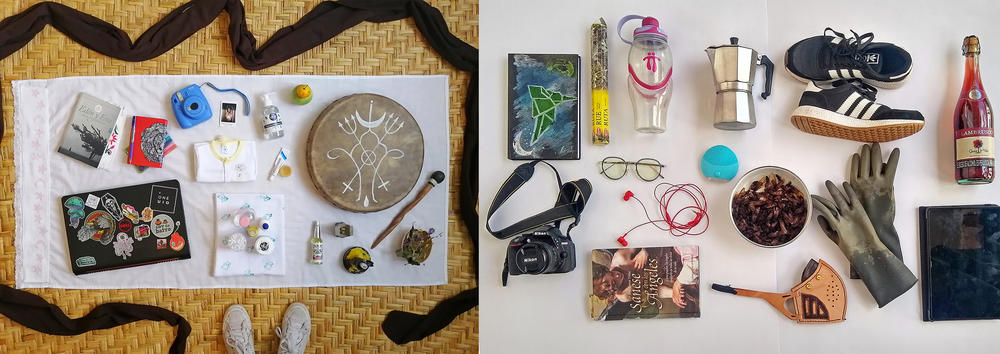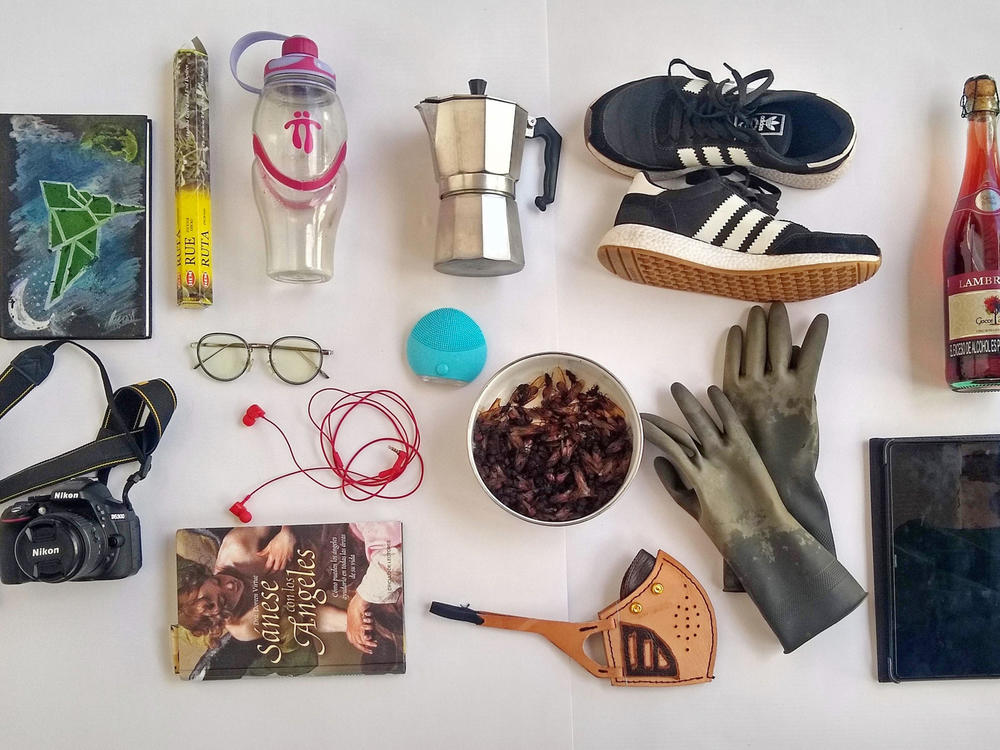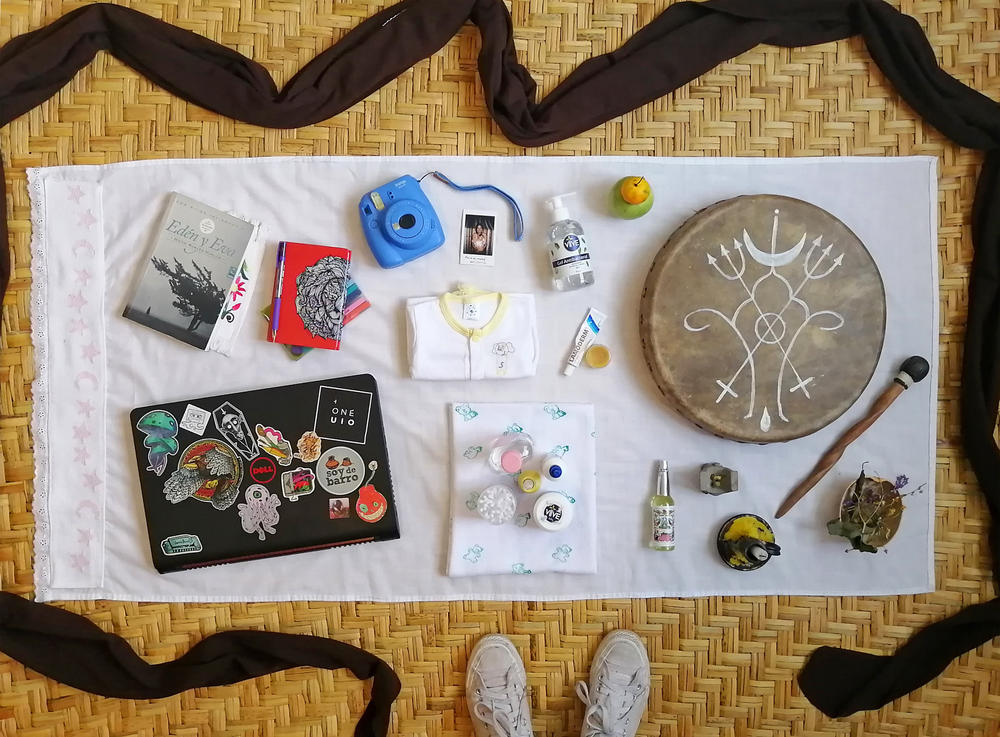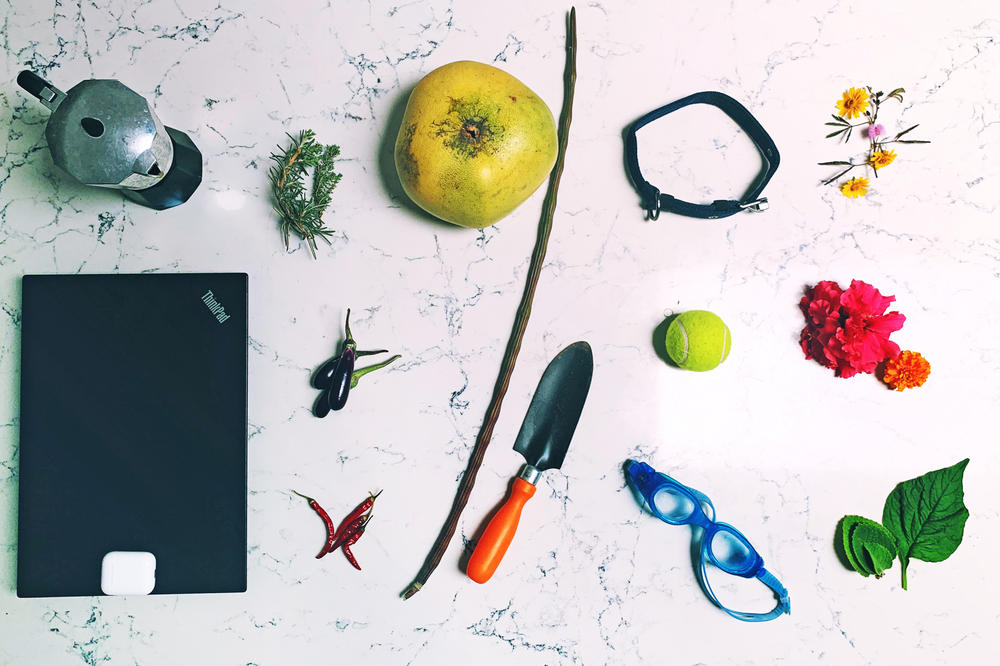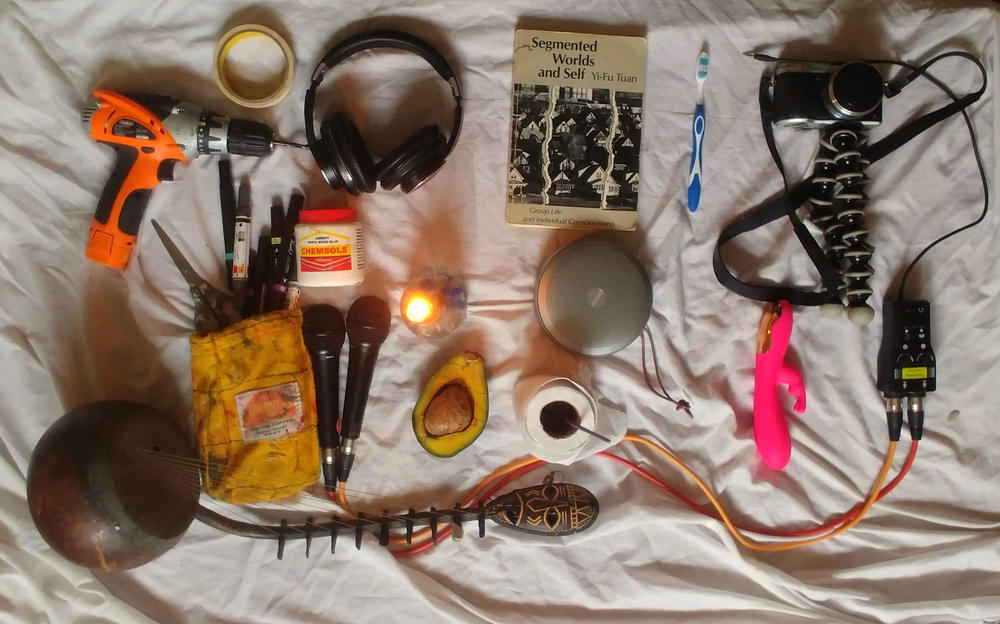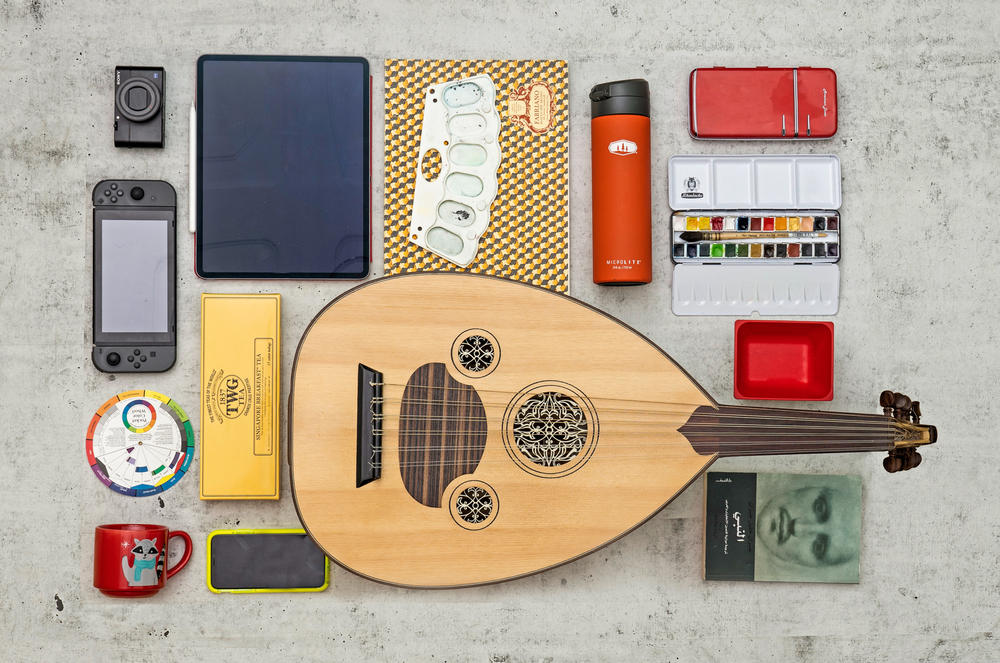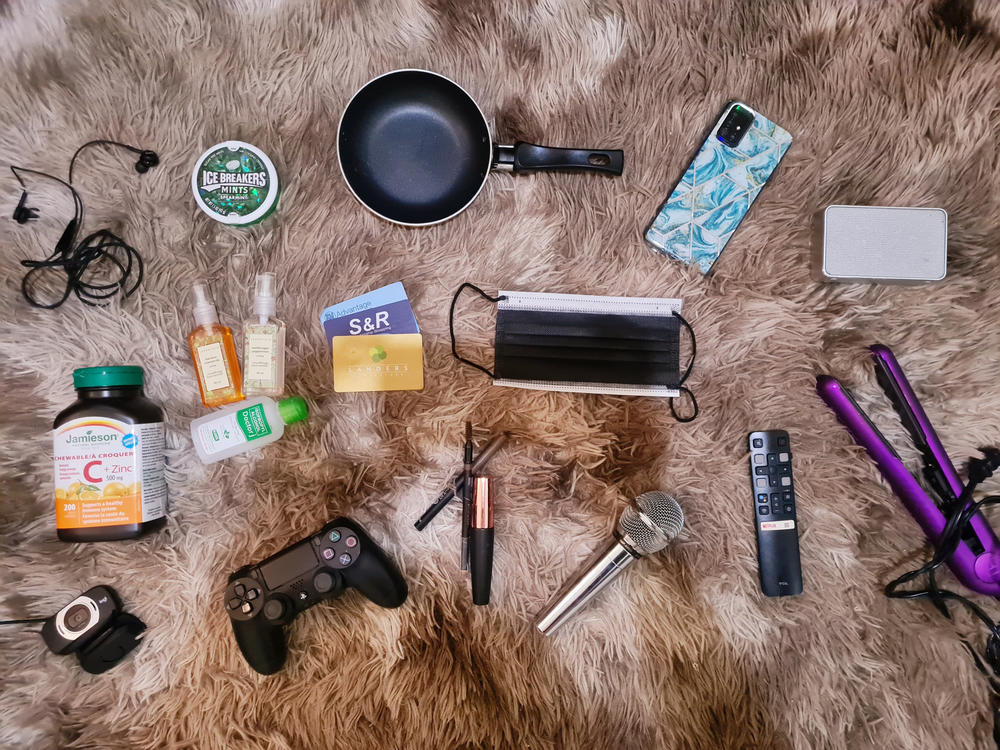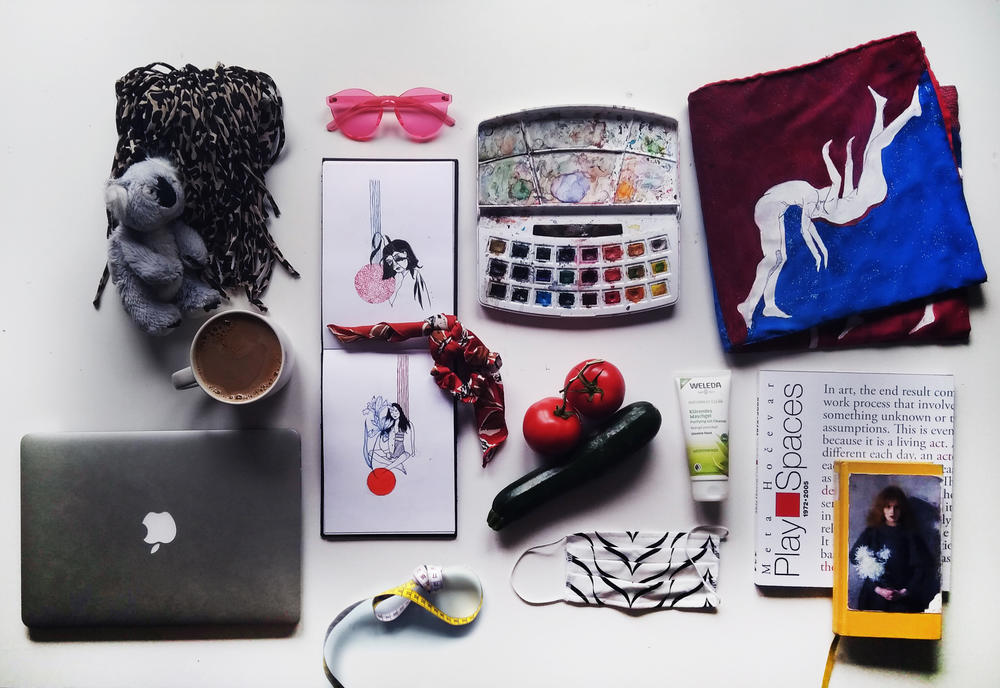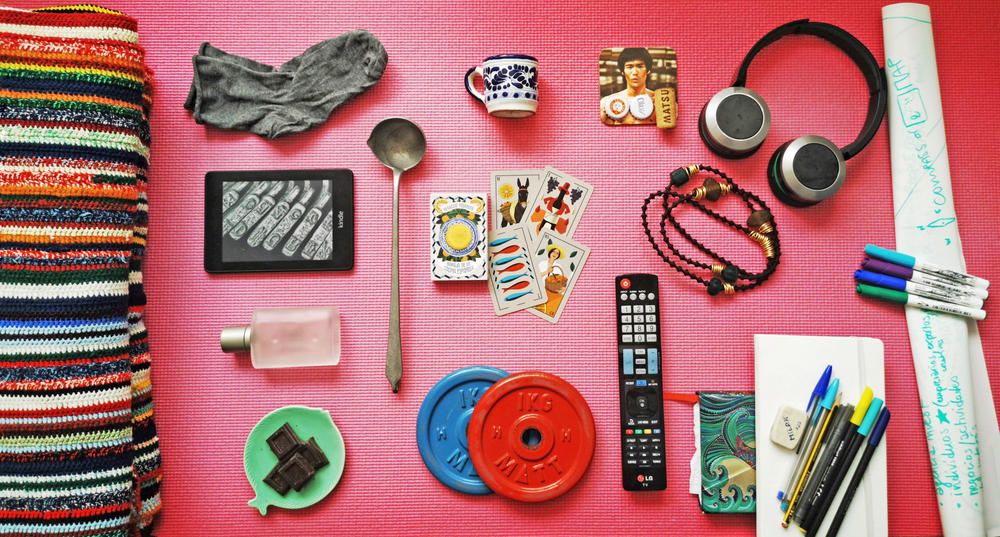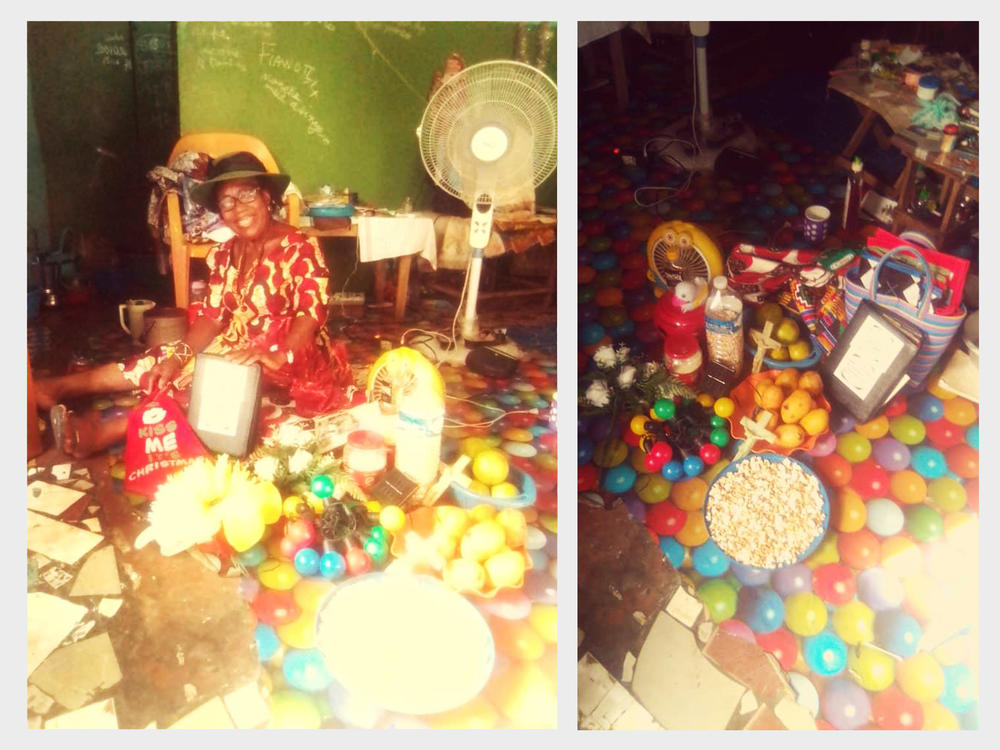Section Branding
Header Content
PHOTOS: 15 Things Folks Can't Live Without In A Pandemic, From Ants To Holy Water
Primary Content
When the pandemic hit, Paula Zuccotti rediscovered her long-neglected vinyl collection. "I'm listening to records I hadn't touched in years," says the Argentine-born, London-based designer and ethnographic researcher. Her job is to notice stuff — meaning people's belongings and how they use them — so this new habit prompted Zuccotti to wonder what other kinds of objects had taken on more central roles in people's lockdown existence.
To find out, she put out a call on Instagram in April 2020, asking, "What are the 15 things that are helping you get through this?" Zuccotti showed off her list of 15, which included a record, a kettlebell and a sage smudge stick, and offered simple directions for folks interested in sharing theirs: Put the items on an even surface, shoot a photo from above, and post the pic with the hashtag #EveryThingWeTouchCovidEssentialsx15.
"I wanted them to use the filter of, 'Here is what I value today.' They don't need to be new things, but maybe they took on a new meaning," explains Zuccotti, who considers this project an extension of the work she did for her 2015 book, Every Thing We Touch: A 24 Hour Inventory of Our Lives, featuring her photos of all of the items several subjects interacted with in a single day. Zuccotti has dubbed this practice of looking at our things as potential artifacts "future archaeology."
And there's certainly a lot to learn about how COVID-19 and its accompanying restrictions have altered routines around the world. Zuccotti compiled the more than 1,000 responses from 50 countries into a publicly searchable archive at lockdownessentials.org. The images aren't always quite as polished as professional shots, but they're extremely telling, especially when paired with the brief descriptions explaining why each item made the cut for an individual's 15.
Common threads quickly became apparent — laptops and headphones are ubiquitous, alongside face masks and hand sanitizer, demonstrating the different ways we have managed to maintain contact with the outside world. Zuccotti appreciates that local goods and cultural practices take on an outsized role, as do flowers and candles and slippers. "There's been a switch in how people see things," she says. "They defined themselves instead by what makes them feel better." Here's a closer look at a few of the images:
Liliana Cadena, Barichara, Colombia
Yes, those are large ants filling that white bowl. Cadena writes that she has a renewed appreciation for these hormigas culonas, a nutritious local delicacy. That particular part of her diet is unusual, but like many other folks, she's been drinking plenty of caffeine and alcohol — as represented by her coffee maker and bottle of Lambrusco. For both, Cadena connects the experience to spending time and meals with her family. Zuccotti likes how Cadena describes her sneakers in the context of no longer worrying so much about how she looks. "I've never felt so confident and comfortable wearing relaxed clothes," Cadena writes. That struck a chord with Zuccotti, whose high heels have also been stashed away.
Maria Belen Morales, Quito, Ecuador
Morales' toes peek into the frame, although she's not actually one of her 15 items. Humans (and the occasional cat) do pop up on other lists and in photos. In Morales' case, her newborn baby Inti is represented by all of the objects related to her care, including the unfurled baby wrap framing the image and the yellow bottle of Agua de Florida "for cleaning and healing rituals." The scented spray is something that's also among Zuccotti's 15 items. "If you are down, you smell it, and you have a boost and feel better," she says.
Padmavathy Krishna Kumar, Bangalore, India
Many of Kumar's items were plucked directly from her garden, which was a visually striking choice. But what really stands out for Zuccotti is how each holds a distinctly different meaning for Kumar. Rosemary and thyme are valued for their scent, the chilies are a "mood uplifting" shade of red, and the spinach and ajwain leaf represent her rediscovery of her mother's cooking.
Naitiemu Nyanjom, Nairobi, Kenya
You can't miss the bright pink vibrator — a sign, Zuccotti says, of the honesty participants brought to this project. The largest item in Nyanjom's collection, however, is the kora, a long-necked harp lute. "I really wanna learn a musical instrument this year," Nyanjom writes. That has been a widespread sentiment, notes Zuccotti, who saw a particular surge of interest in people reconnecting with their culture through music.
Mohamad Chehimi, Kuwait City, Kuwait
Chehimi spent lockdown at home, but not in his home country. So like other contributors "in a place that's not their place," as Zuccotti describes it, the Lebanon native found ways to bridge the distance. There's Lebanese-American author Kahil Gibran's The Prophet, a book he's read three times. There's also a Nintendo Switch, which Chehimi used "to meet my friends 'virtually' playing online games such as Animal Crossing."
Sheena, Manila, Philippines
"As everyone is using face masks and half my face is covered, I make sure that my eyes look alluring and pretty," Sheena writes to explain why eye make-up is in her list of 15. She's also included hair straighteners because she has been experimenting with different styles and colors. This focus on appearance is possibly linked to Zuccotti's favorite object in the photo: the karaoke microphone. With bars shut, Manila residents like Sheena turned to home karaoke in droves. Parents complained that their homeschooled kids were so distracted by the ruckus that the government banned "karaokes, videokes and other sound producing devices" during daylight hours.
Magdalena Zajac, Ljubljana, Slovenia
A little stuffed koala is "a friend spending the whole quarantine with me," the international exchange student from Poland writes. That's a positive way to view the situation — something Zuccotti saw expressed in a variety of ways. (Check out Rino from Tokyo, Japan, who has a drawing of fingers crossed.) Zajac's collection also includes a pair of rose-colored spectacles that emphasize her sunny outlook. "In my country, we use the expression 'look through pink glasses' to assume a generally optimistic and cheerful attitude," she writes.
Vittoria Tedaldi, Madrid, Spain
Tedaldi titled her photo, "Walking barefoot through lockdown," so the pair of socks pictured were an anti-essential — being at home meant she didn't need to wear them. She writes that "we suddenly had time to play," which is why there's that eye-catching set of playing cards honoring Spanish culinary history, illustrated by artist Silja Goetz. Tedaldi's steel spoon, which she includes as a nod to "cooking as a way of caring," also stands out to Zuccotti. She notes that in several American photos, spoons that were used to cheer essential workers by banging on pots held a different meaning.
Dati Agno, Lome, Togo
Not every contributor is on Instagram. Zuccotti's trainer at her London gym hails from Togo, and when she told him about her project, he convinced his grandmother to submit her 15 items. Agno's list is loaded with relatively basic needs, such as fruit, flour and a fan. And like many images from Africa, she includes a Bible. Zuccotti notes that these types of items are a sign that even as many of us changed the essential things in our lives, others found comfort in their usual objects.
Your Turn: Send Us A Photo Of One Of Your Pandemic Essentials
We'd love to see your pandemic essentials! Send us a photo of yourself posing with one object that's helping you get through the COVID crisis (that isn't a laptop or a phone!). In a few sentences, tell us why it's important to you. Horizontal images are much appreciated. Email the photo and caption, plus your name and location, to goatsandsoda@npr.org with the subject line "My pandemic essential." We may feature it in a future story on NPR.org. The deadline is July 6.
Copyright 2021 NPR. To see more, visit https://www.npr.org.
